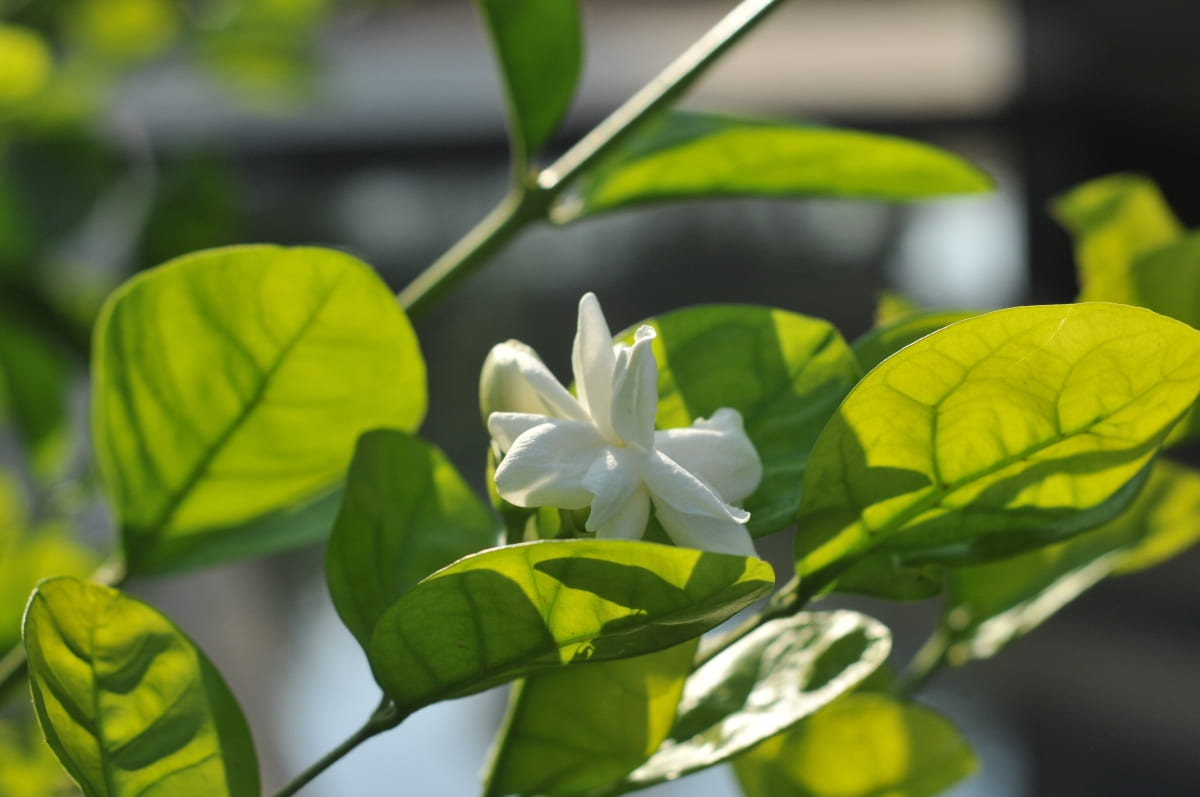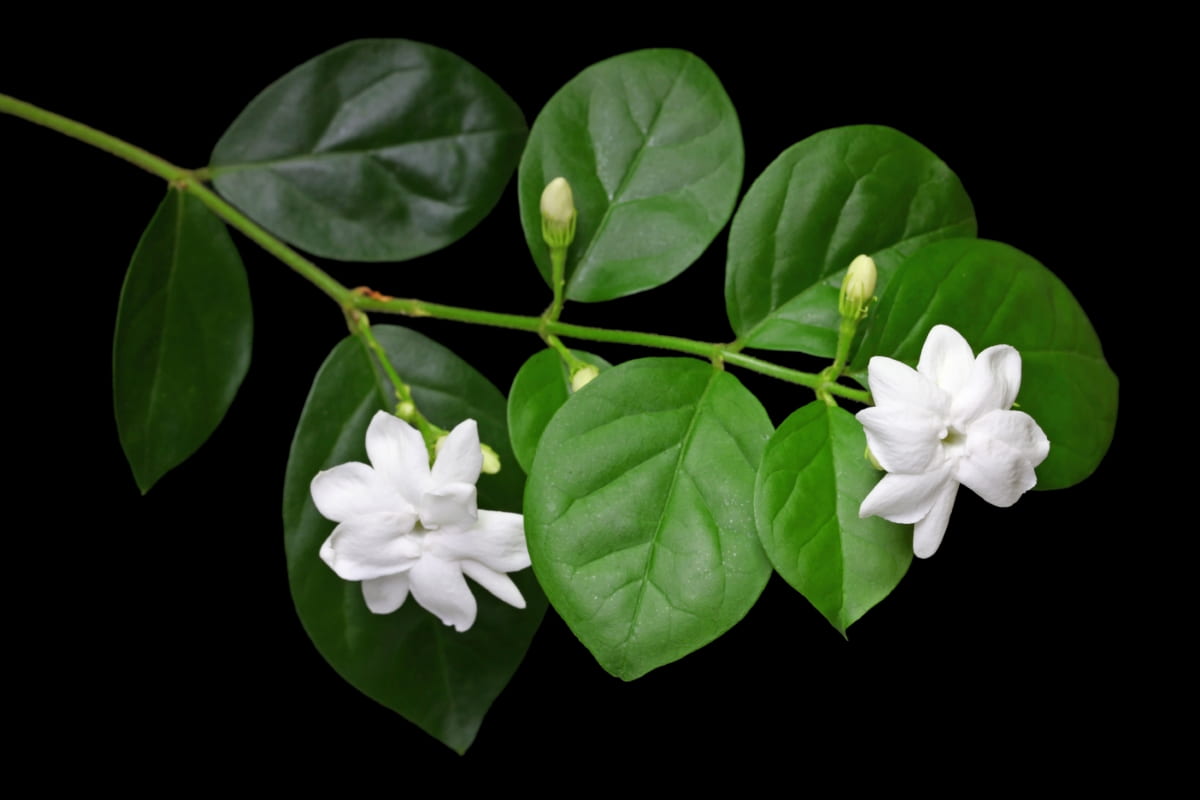The Indian Mogra flower, scientifically known as Jasminum sambac, is fragrant and revered in Indian culture. Also called Arabian Jasmine, it boasts white, delicate, and star-shaped blooms with a sweet, intoxicating scent. Widely used in religious ceremonies, the Mogra is symbolic of purity, love, and divine beauty. It’s a popular choice for garlands, perfumes, and traditional decorations, often seen adorning temples and used in wedding rituals. Beyond its aesthetic appeal, the Mogra holds cultural significance, reflecting its deep-rooted presence in Indian traditions.

Indian Mogra Flower
Cultivation and Distribution of Indian Mogra Flower
Indian Mogra flowers thrive in tropical and subtropical climates, favoring well-drained soil and ample sunlight. Widely cultivated across India, particularly in states like Tamil Nadu, Karnataka, and West Bengal, it also grows in Southeast Asian countries. The plant is propagated through cuttings and requires regular pruning to maintain its shape and also to promote flower production. The distribution spans home gardens, commercial nurseries, and farms, ensuring a steady supply for various purposes, from religious practices to the fragrance industry.
Medicinal Uses of Indian Mogra Flower
In addition to its cultural and ornamental significance, the Indian Mogra flower has medicinal properties. Mogra oil, extracted from its blossoms, is known for its calming and stress-relieving effects. The extracted oil is used in aromatherapy to alleviate anxiety and induce relaxation. Additionally, Mogra extracts are believed to have antiseptic and anti-inflammatory properties, making them useful choice in traditional medicine.
The flowers are sometimes infused in teas or decoctions to treat ailments like coughs and respiratory issues. While its primary role is cultural and aesthetic, the Indian Mogra flower’s medicinal attributes contribute to its versatile and holistic appeal.
Aromatic Applications of Indian Mogra Flower
The Indian Mogra flower is celebrated for its enchanting fragrance, making it a prized ingredient in the perfume and essential oil industry. The extraction of Mogra oil involves steam distillation of the blossoms, yielding a rich, sweet-scented oil. This aromatic oil is a key component in high-end perfumes, attars, and scented products.
Its captivating fragrance, reminiscent of jasmine, adds depth and allure to various fragrance compositions. Beyond perfumery, Mogra oil is utilized in aromatherapy for its therapeutic properties, promoting relaxation and reducing stress. The aromatic essence of the Indian Mogra flower not only enhances the olfactory experience but also contributes to its widespread application in the fragrance and wellness industries.
Ornamental Value of Indian Mogra Flower
The Indian Mogra flower holds significant ornamental value, gracing gardens, landscapes, and ceremonial spaces with its pristine beauty. The plant’s lush, green foliage provides an elegant backdrop to the star-like white blossoms, creating visually stunning displays. Mogra is a popular choice for landscaping, often cultivated as hedging or as standalone ornamental shrubs.
Its use in traditional decorations, such as garlands and floral arrangements, adds a touch of sophistication to religious ceremonies, weddings, and festive occasions. The enduring appeal of the Indian Mogra flower as an ornamental plant lies in its timeless beauty, making it a symbol of purity and grace in diverse cultural contexts.
Challenges in the Cultivation of Indian Mogra Flower
Despite its cultural and economic importance, the cultivation of Indian Mogra flowers poses several challenges. These plants are vulnerable to pests and diseases, requiring careful monitoring and pest control measures. Weather conditions, especially excessive rainfall or extreme temperatures, can impact flower production.
In case you missed it: How to Grow Mogra/Jasmine from Cuttings: DYI in 10 Simple Steps

Also, maintaining optimal soil conditions and proper pruning practices are essential for sustained cultivation. The delicate nature of the flowers makes them vulnerable to damage during transportation, affecting the quality of harvested blooms. Balancing the need for sunlight and protection from harsh weather conditions further complicates cultivation efforts.
Harvesting and Processing of Indian Mogra Flower
Harvesting Indian Mogra flowers requires meticulous timing to capture their peak fragrance and freshness. Typically done early in the morning when the blooms are at their most fragrant, skilled harvesters handpick the delicate flowers. Post-harvest, the flowers undergo processing, with careful sorting to eliminate damaged or imperfect blooms.
The preferred method of extraction is steam distillation, where the aromatic compounds are carefully distilled to produce Mogra oil. The oil undergoes further refining and quality checks before being incorporated into perfumes, essential oils, and other aromatic products. The harvesting and processing of Indian Mogra flowers demand precision and expertise to preserve their aromatic essence and meet the high standards of the fragrance industry.
Cultural Significance of Indian Mogra Flower
The Indian Mogra flower holds profound cultural significance and is deeply embedded in various traditions and ceremonies. It is a symbol of purity, love, and beauty in Hindu culture, often used in religious rituals and ceremonies. Mogra flowers are extensively used in weddings, adorning the bride, groom, and the venue. The fragrance of the flower is believed to have spiritual significance, connecting individuals with divine energies.
The use of Mogra in garlands, religious offerings, and decorations is a testament to its enduring cultural relevance. In literature and art, the Mogra is a recurring motif, representing beauty, grace, and the ephemeral nature of life. Its cultural symbolism extends beyond India, making it a cherished flower in diverse cultural expressions and artistic representations.
Future Prospects of Indian Mogra Flower
The prospects of the Indian Mogra flower are promising, driven by its continued demand in various industries and cultural contexts. With the rising popularity of natural and traditional products, Mogra oil’s applications in perfumery, aromatherapy, and skincare are expected to expand. Sustainable cultivation practices and research into disease-resistant varieties may address cultivation challenges, ensuring a stable supply of high-quality blossoms.
In case you missed it: How to Control Jasmine Pests Naturally: How to Get Rid of Them with Natural and Organic Treatment

The global interest in aromatherapy and wellness further enhances the flower’s market potential. Additionally, the ornamental value of the Mogra continues to contribute to its popularity in landscaping and gardening. As awareness of its cultural significance spreads, the Indian Mogra flower is poised to maintain its iconic status while adapting to emerging trends in the fragrance and horticultural industries.
Conclusion
In conclusion, the Indian Mogra flower, with its enchanting fragrance and cultural significance, weaves a tapestry of beauty and tradition. From ornamental gardens to perfumery, its uses are diverse, while cultivation poses challenges addressed by ongoing research. The Mogra’s timeless appeal, both aromatic and aesthetic, ensures its continued prominence, promising a fragrant future in various industries and cultural practices.
- Feed Your Flock for Less: Top 10 Tips to Save on Chicken Feed
- Ultimate Guide to Ossabaw Island Hog: Breeding, Raising, Diet, and Care
- Hatching Answers: The Top 10 Reasons Your Chickens Aren’t Laying Eggs
- Eggs and Economics: Breaking Down the Cost of Raising Backyard Chickens
- Defend Your Greens: Proven Methods to Keep Iguanas Out of Your Garden
- Ultimate Guide to Cinnamon Queen Chicken: A Comprehensive Guide for Beginners
- Ultimate Guide to California Tan Chicken: Breeding, Raising, Diet, Egg-Production and Care
- Ultimate Guide to Marsh Daisy Chicken: Breeding, Raising, Diet, and Care
- 10 Types of Chicken Farming Businesses You Can Start for Profits